
Fish migration is mass relocation by fish from one area or body of water to another. Many types of fish migrate on a regular basis, on time scales ranging from daily to annually or longer, and over distances ranging from a few metres to thousands of kilometres. Such migrations are usually done for better feeding or to reproduce, but in other cases the reasons are unclear.
Sturgeon is the common name for the 28 species of fish belonging to the family Acipenseridae. The earliest sturgeon fossils date to the Late Cretaceous, and are descended from other, earlier acipenseriform fish, which date back to the Early Jurassic period, some 174 to 201 million years ago. They are one of two living families of the Acipenseriformes alongside paddlefish (Polyodontidae). The family is grouped into four genera: Acipenser, Huso, Scaphirhynchus, and Pseudoscaphirhynchus. Two species may be extinct in the wild, and one may be entirely extinct. Sturgeons are native to subtropical, temperate and sub-Arctic rivers, lakes and coastlines of Eurasia and North America. A Maastrichtian-age fossil found in Morocco shows that they also once lived in Africa.
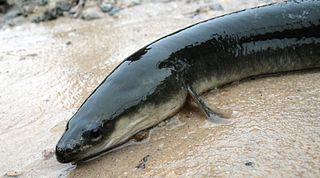
The American eel is a facultative catadromous fish found on the eastern coast of North America. Freshwater eels are fish belonging to the elopomorph superorder, a group of phylogenetically ancient teleosts. The American eel has a slender, supple, snake-like body that is covered with a mucus layer, which makes the eel appear to be naked and slimy despite the presence of minute scales. A long dorsal fin runs from the middle of the back and is continuous with a similar ventral fin. Pelvic fins are absent, and relatively small pectoral fins can be found near the midline, followed by the head and gill covers. Variations exist in coloration, from olive green, brown shading to greenish-yellow and light gray or white on the belly. Eels from clear water are often lighter than those from dark, tannic acid streams.
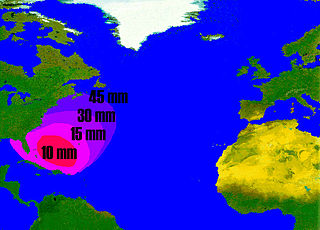
Eels are any of several long, thin, bony fishes of the order Anguilliformes. They have a catadromous life cycle, that is: at different stages of development migrating between inland waterways and the deep ocean. Because fishermen never caught anything they recognized as young eels, the life cycle of the eel was a mystery for a very long period of scientific history that continues into the present day. Of significant interest is the search for the spawning grounds for the various species of eels and identifying impacts to population decline in each stage of the life cycle.

The kaluga, also known as the river beluga, is a large predatory sturgeon found in the Amur River basin. With a maximum size of at least 1,000 kg (2,205 lb) and 5.6 m (18.6 ft), the kaluga is one of the biggest of the sturgeon family. Like the slightly larger beluga, it spends part of its life in salt water. Unlike the beluga, this fish has 5 major rows of dermal scutes and feeds on salmon and other fish in the Amur. They have gray-green to black backs with a yellowish green-white underbelly.

The common galaxias or inanga is a very widespread Southern Hemisphere fish in the family Galaxiidae. It is a slim, narrow fish with a forked tail and a mottled, spotty pattern, typically about 10 cm (4 in) long when fully grown. It lives in fresh water, but spawns at river mouths and spends the first six months of its life at sea, returning en masse in spring. Its vernacular names include cowfish, jollytail, common jollytail, eel gudgeon, inaka, native trout, pulangi, puye, slippery tarki, spotted minnow, Falklands minnow and whitebait.
The lake sturgeon, also known as the rock sturgeon, is a North American temperate freshwater fish, one of about 25 species of sturgeon. Like other sturgeons, this species is a bottom feeder and has a partly cartilaginous skeleton, an overall streamlined shape, and skin bearing rows of bony plates on the sides and back.
The Chinese sturgeon is a critically endangered member of the family Acipenseridae in the order Acipenseriformes. Historically, this anadromous fish was found in China, Japan, and the Korean Peninsula, but it has been extirpated from most regions due to habitat loss and overfishing.

The European sea sturgeon, also known as the Atlantic sturgeon or common sturgeon, is a species of sturgeon native to Europe. It was formerly abundant, being found in coastal habitats all over Europe. It is anadromous and breeds in rivers. It is currently a critically endangered species. Although the name Baltic sturgeon sometimes has been used, it has now been established that sturgeon of the Baltic region are A. oxyrinchus, a species otherwise restricted to the Atlantic coast of North America.

White sturgeon is a species of sturgeon in the family Acipenseridae of the order Acipenseriformes. They are an anadromous (migratory) fish species ranging in the Eastern Pacific; from the Gulf of Alaska to Monterey, California. However, some are landlocked in the Columbia River Drainage, Montana, and Lake Shasta in California, with reported sightings in northern Baja California, Mexico.

The Atlantic sturgeon is a member of the family Acipenseridae, and, along with other sturgeon, it is sometimes considered a living fossil. The Atlantic sturgeon is one of two subspecies of A. oxyrinchus, the other being the Gulf sturgeon. The main range of the Atlantic sturgeon is in eastern North America, extending from New Brunswick, Canada, to the eastern coast of Florida, United States. A disjunct population occurs in the Baltic region of Europe. The Atlantic sturgeon was in great abundance when the first European settlers came to North America, but has since declined due to overfishing, water pollution, and habitat impediments such as dams. It is considered threatened, endangered, and even locally extinct in many of its original habitats. The fish can reach 60 years of age, 15 ft (4.6 m) in length and over 800 lb (360 kg) in weight.

The sterlet is a relatively small species of sturgeon from Eurasia native to large rivers that flow into the Black Sea, Azov Sea, and Caspian Sea, as well as rivers in Siberia as far east as Yenisei. Populations migrating between fresh and salt water (anadromous) have been extirpated.Also known as Sterlet sturgeon.
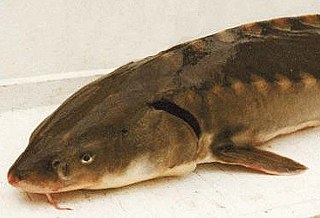
The shortnose sturgeon is a small and endangered species of North American sturgeon. The earliest remains of the species are from the Late Cretaceous Period, over 70 million years ago. Shortnose sturgeons are long-lived and slow to sexually mature. Most sturgeons are anadromous bottom-feeders, which means they migrate upstream to spawn but spend most of their lives feeding in rivers, deltas and estuaries. The shortnose sturgeon is often mistaken as a juvenile Atlantic sturgeon because of its small size. Prior to 1973, U.S. commercial fishing records did not differentiate between the two species: both were reported as "common sturgeon", although it is believed based on sizes that the bulk of the catch was Atlantic sturgeon. The shortnose is distinguishable from the Atlantic sturgeon due to its shorter and rounder head.
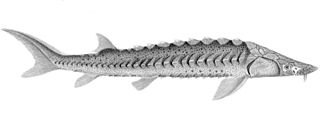
The green sturgeon is a species of sturgeon native to the northern Pacific Ocean, from China and Russia to Canada and the United States.

The Gulf sturgeon is a subspecies of sturgeon that lives in the Gulf of Mexico and some rivers draining into it. The Gulf sturgeon was first recognized as a separate subspecies in 1955. The nominate subspecies is the Atlantic sturgeon, A. o. oxyrinchus. The Gulf sturgeon is listed as threatened under the United States Endangered Species Act, having been listed in 1991. Critical habitat, reflecting the range of the subspecies deemed essential for its continued survival, has been designated. The historical range is thought to have been from the Suwannee River on the western coast of Florida to the Mississippi River, and marine waters of the central and eastern portions of the Gulf of Mexico. Three sturgeon species in genus Scaphirhynchus share river territory with the Gulf sturgeon; none of the other sturgeon species is anadromous.

The Adriatic sturgeon is a species of fish in the family Acipenseridae. It is native to the Adriatic Sea and large rivers which flow in it of Albania, Greece, Italy, Montenegro, Croatia, Bosnia and Herzegovina and Slovenia. Specimens can be seen in several public aquarium, such the Milan Aquarium, Aquarium Finisterrae, Aquarium of the Po, and Oasis of Sant'Alessio in Lombardy.
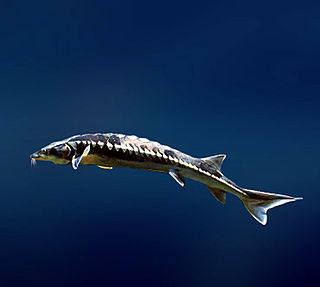
The bastard sturgeon, also known as the fringebarbel sturgeon, ship sturgeon, spiny sturgeon, or thorn sturgeon, is a species of fish in the family Acipenseridae. These fish are typically found along the benthos of shallower waters near shorelines or estuaries.

The houting is a European species of whitefish in the family Salmonidae that was long thought extinct. It was native to the estuaries and rivers draining to the North Sea. The houting is distinguishable from other Coregonus taxa by having a long, pointed snout, an inferior mouth and a different number of gill rakers. The houting once occurred in Belgium, France, Germany, the Netherlands and England. In 2023, DNA analysis found the houting to be genetically indistinguishable from Coregonus lavaretus, and therefore not extinct.

The European flounder is a flatfish of European coastal waters from the White Sea in the north to the Mediterranean and the Black Sea in the south. It has been introduced into the United States and Canada accidentally through transport in ballast water. It is caught and used for human consumption.

Tarpon are fish of the genus Megalops. They are the only members of the family Megalopidae. Of the two species, one is native to the Atlantic, and the other to the Indo-Pacific Oceans.


















